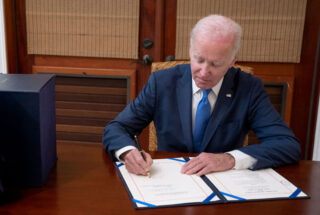A DARPA for K–12? Omnibus bill includes substantial new funds for education R&D
Kevin Mahnken | January 9, 2023
Your donation will help us produce journalism like this. Please give today.
Funding increases written into the recently passed $1.7 trillion federal omnibus package will provide a substantial jumpstart to education research and statistics this year — and could even evolve into an entity mirroring DARPA, the Pentagon’s storied research and development branch.
The law, passed by bipartisan majorities and signed by President Biden in the closing days of 2022, includes a $70 million boost to the Institute for Education Sciences, the Department of Education’s arm for statistics, research, and evaluation. Within that 9.6 percent bump — which brings IES’s overall budget to $808 million — $40 million are allocated for research, development, and dissemination, including an unspecified amount intended to foster “quick-turnaround, high-reward scalable solutions intended to improve education outcomes for all students.”
That initiative will be housed within the National Center for Education Research, one of the Institute’s four research and statistics hubs, with the hope that it will eventually be spun off into a fifth such center. In an interview with The 74, IES Director Mark Schneider described the infusion of money as a down payment toward “something the department’s been talking about for 20 years.”
“I will be pushing for a separate center,” Schneider said, adding that he and his colleagues were “ecstatic” with what Congress provided. “There’s no question about it, this is a major accomplishment. The department, IES, and many people outside have spent a lot of time and energy trying to get this established.”
The bill’s passage comes after what some in the academic community have called a decade of disinvestment in federal education research. In the wake of cuts or freezes to funding in the Obama administration, the Institute’s National Center for Education Statistics had to alter its calendar for administering the federal K–12 assessment known as “the Nation’s Report Card,” one of the U.S. Department of Education’s best-known products.
More recently, the Institute announced that it would not be offering competitive grant programs in research methodology or systemic replication in education research in Fiscal Year 2023. Those technical-sounding competitions make up much of the federal government’s R&D infrastructure for K–12, contributing to the emergence of ideas and products that improve student learning.
In the hopes of reversing those developments — and spurring a nationwide recovery from COVID-related disruptions to school — Congressional Democrats and Republicans teamed up last summer to offer legislation that would have created a “National Center for Advanced Development in Education.” That proposal would have authorized an organization with the specific intention of advancing scalable advances in teaching methods and technology, such as voice recognition software to assess dyslexia. While language authorizing the so-called “NCADE” was included in the House’s FY 2023 budget proposal, it didn’t make it into the bill that ultimately passed Congress.
Rep. Suzanne Bonamici, an Oregon Democrat who co-sponsored the NCADE legislation last year, said in a statement that she would continue working to create a new center within IES in 2023.
“The [IES] funding increase and language included in the omnibus is a win for innovation in education research,” Bonamici said. “This is an exciting opportunity to expedite the development and adoption of emerging technologies, helping more students and quickly closing learning gaps.”
The idea for a national K–12 center focused on research and development predates both the pandemic and the last few presidential administrations. President Obama’s 2012 budget proposal explicitly called for the creation of such a body, invoking the example of DARPA, the advanced defense research agency that is credited with bringing about such technological innovations as weather satellites, GPS, and the internet.
The comparative latitude granted to DARPA, which can contract with research partners across multiple sectors and maintains significant flexibility over project deadlines, differs somewhat from Washington’s existing K–12 research institutions. Felice Levine, executive director of the American Education Research Association, said in a statement that the funding offered in the omnibus bill would prove valuable to researchers, policymakers and professional educators at a time when millions of students have experienced setbacks to learning and social-emotional development.
The federal investment represents “a vote of confidence in the role high-quality education research needs to play in identifying and countering the devastating impacts of the pandemic on the nation’s students,” Levine said.
Schneider added that he hopes to spend much of 2023 reorganizing the Institute — possibly by moving its work on prize competitions and transformative research, as well as the Small Business Innovation Research program into the newly established unit — before pushing Congress again to consider a new “NCADE” center.
“We’ve been pushing on this, we’ve been trying to increase the rapidity of our experiments, we’ve tried to make sure there’s replication, we’ve increased our demands for dissemination and scaling up,” Schneider said. “We have a really developed model of what a modern education R&D infrastructure looks like, and…I’m hoping this new unit will be a catalyst to continue to push that change, and ultimately the foundation for NCADE.”
This article was published in partnership with The 74. Sign up for The 74’s newsletter here.
